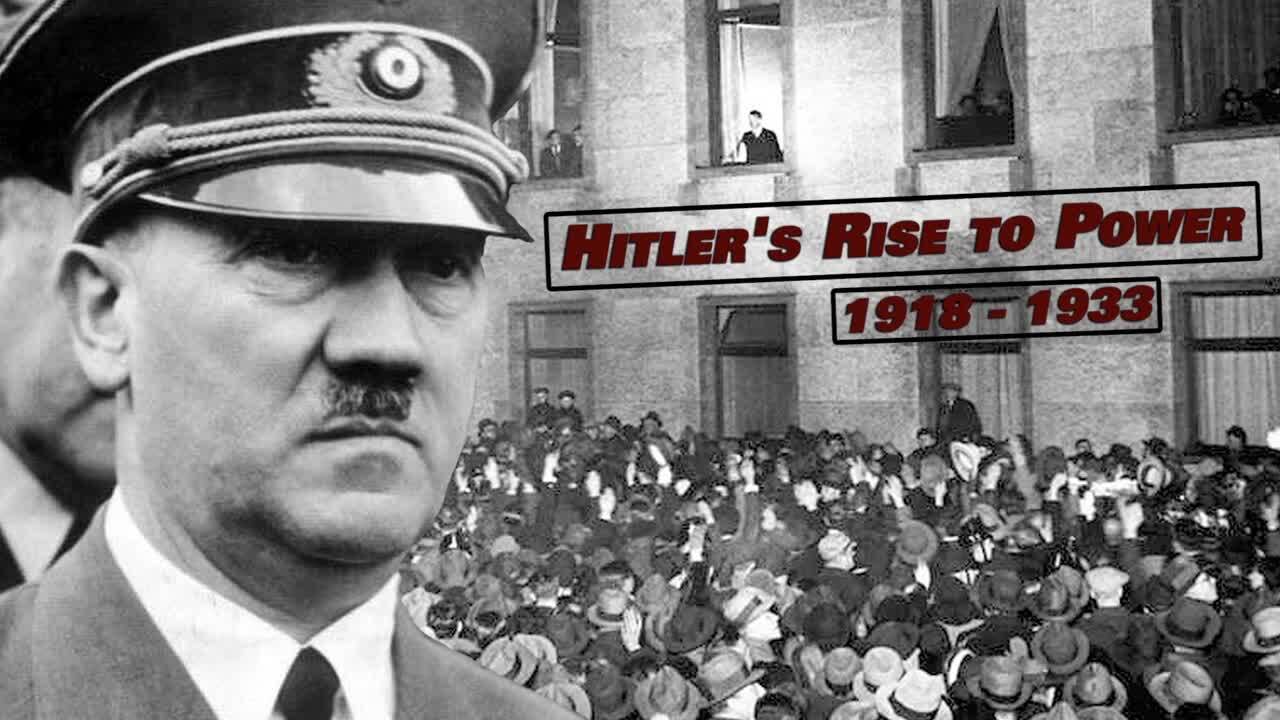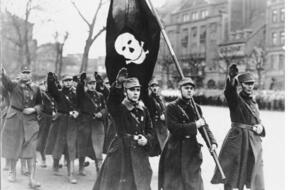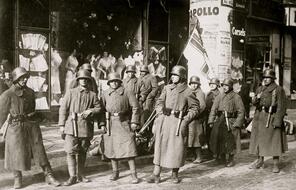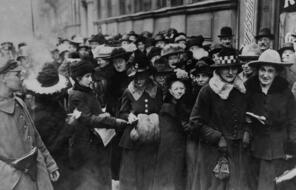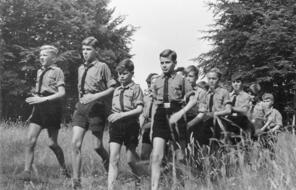Adolf Hitler, an Austrian-born corporal in the German army during World War I, capitalized on the anger and resentment felt by many Germans after the war as he entered politics in 1919, joined the small German Workers’ Party, and quickly became the party’s leader. By February 1920, Hitler had given it a new name: the National Socialist German Workers’ Party (Nationalsozialistische Deutsche Arbeiterpartei), or Nazi, for short.
Originally drafted in 1920, the Nazi Party platform (see the reading National Socialist German Workers’ Party Platform) reflects a cornerstone of Nazi ideology: the belief in race science and the superiority of the so-called Aryan race (or “German blood”). For the Nazis, so-called “German blood” determined whether one was considered a citizen. The Nazis believed that citizenship should not only bestow on a person certain rights (such as voting, running for office, or owning a newspaper); it also came with the guarantee of a job, food, and land on which to live. Those without “German blood” were not citizens and therefore should be deprived of these rights and benefits.
Fueled by post-war unrest and Hitler’s charismatic leadership, thousands joined the Nazis in the early 1920s. In an attempt to capitalize on the chaos caused by runaway hyperinflation, Hitler attempted to stage a coup (known as the Beer Hall Putsch) in Munich to overthrow the government of the German state of Bavaria on November 23, 1923. The attempt failed and resulted in several deaths. Hitler and several of his followers were arrested, but rather than diminish his popularity, Hitler’s subsequent trial for treason and imprisonment made him a national figure.
At the trial, a judge sympathetic to the Nazis’ nationalist message allowed Hitler and his followers to show open contempt for the Weimar Republic, which they referred to as a “Jew government.” Hitler and his followers were found guilty. Although they should have been deported because they were not German citizens (they were Austrian citizens), the judge dispensed with the law and gave them the minimum sentence—five years in prison. Hitler only served nine months, and the rest of his term was suspended.
During his time in prison, Hitler wrote Mein Kampf (My Struggle). In the book, published in 1925, he maintained that conflict between the races was the catalyst of history. Because he believed that the “Aryan” race was superior to all others, he insisted that “Aryan” Germany had the right to incorporate all of eastern Europe into a new empire that would provide much-needed Lebensraum, or living space, for it. That new empire would also represent a victory over the Communists, who controlled much of the territory Hitler sought. Hitler, like many conservative Germans, regarded both Communists and Jews as enemies of the German people. He linked the Communists to the Jews, using the phrase “Jewish Bolshevism” and claiming that the Jews were behind the teachings of the Communist Party. (The Bolsheviks were the communist group that gained power in Russia in 1917 and established the Soviet Union.) The Jews, according to Hitler, were everywhere, controlled everything, and acted so secretly and deviously that few could detect their influence.
By 1925, Hitler was out of prison and once again in control of the Nazi Party. The attempted coup had taught him an important lesson. Never again would he attempt an armed uprising. Instead, the Nazis would use the rights guaranteed by the Weimar Constitution—freedom of the press, the right to assemble, and freedom of speech—to win control of Germany.
However, in 1924 the German economy had begun to improve. By 1928, the country had recovered from the war and business was booming. As a result, fewer Germans seemed interested in the hatred that Hitler and his Nazi Party promoted. The same was true for other extreme nationalist groups. In the 1928 elections, the Nazis received only about 2% of the vote.
Then, in 1929, the stock market crashed and the worldwide Great Depression began. Leaders around the world could not stop the economic collapse. To an increasing number of Germans, democracy appeared unable to rescue the economy, and only the most extreme political parties seemed to offer clear solutions to the crisis.
The Communist Party in Germany argued that to end the depression, Germany needed a government like the Soviet Union’s: the government should take over all German land and industry from capitalists, who were only interested in profits for themselves. Communists promised to distribute German wealth according to the common good. The Nazis blamed the Jews, Communists, liberals, and pacifists for the German economic crisis. They promised to restore Germany’s standing in the world and Germans’ pride in their nation as well as end the depression, campaigning with slogans such as “Work, Freedom, and Bread!”
Many saw the Nazis as an attractive alternative to democracy and communism. Among them were wealthy industrialists who were alarmed by the growth of the Communist Party and did not want to be forced to give up what they owned. Both the Communists and the Nazis made significant gains in the Reichstag (German parliament) elections in 1930.
In 1932, Hitler became a German citizen so that he could run for president in that year’s spring election. His opponents were Ernst Thälmann, the Communist candidate, and Paul von Hindenburg, the independent, conservative incumbent. In the election, 84% of all eligible voters cast ballots, and the people re-elected President Hindenburg. Hitler finished second. But in elections for the Reichstag held four months later, the Nazis’ popularity increased further. They won 37% of the seats in the legislature, more than any other party, and 75 seats more than their closest competitor, the Social Democrats.
President Hindenburg and his chancellors could not lift Germany out of the depression. Their popular support began to shrink. In January 1933, Hindenburg and his advisors decided to make a deal with Hitler. He had the popularity they lacked, and they had the power he needed. Hindenburg’s advisors believed that the responsibility of being in power would make Hitler moderate his views. They convinced themselves that they were wise enough and powerful enough to “control” Hitler. They were also certain that he, too, would fail to end the depression. When he failed, they would step in to save the nation. But they were tragically mistaken.





